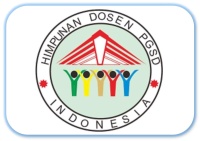Penggunaan model polya pada soal cerita perkalian dan pembagian pecahan di sekolah dasar
Abstract
This research was motivated by the lack of the use of learning models in the learning process on fraction material that causes students’ learning outcomes to be low. This study aims to fine out the effect of using Polya model on learning outcomes on multiplication and division problem in grade V SD group VI Akabiluru District. The research design was quasi experiment with nonequivalent control group design. The sampel of the research was grades of SDN 02 Suayan. Moreover, the result showed that there was an influence on the use of Polya model on students’ learning outcomes. The result t-test on α 0.05 and df 16 of was obtained tcount (2,33) ≥ ttable (2.04) and the average experimental class was 70.3 and 46.1 in control class.
Keywords : polya model, question of the story multiplication and division, learning outcomes.
References
Anitah, Sri. 2008: Strategi Pembelajaran di SD. Jakarta : UT
Arikunto, Suharsimi. 2006. Prosedur Penelitian Suatu Pendekatan Praktik. Jakarta: Rineka Cipta.
Djamarah, Saiful Bahri, dkk. 2000. Strategi Belajar Mengajar Cetakan ke-2.Jakarta : Rineka Cipta.
Muhsetyo, Gatot, dkk. 2008. Pembelajaran Matematika SD. Jakarta : UT
Polya, George. 1973. How To Solve It: A New Aspect of Mathematical Method. New Jersey : Princeton University Press.
Polya, George. 2002. How To Solve It: A New Aspect of Mathematical Method. New Jersey : Princeton University Press.
Sugiyono. 2012. Metode Penelitian Pendidikan:Pendekatan Kuantitatif, Kualitatif, dan R & D. Bandung: Alfabeta.
DOI: http://dx.doi.org/10.24036/e-jipsd.v6i2.4500


